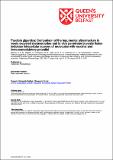| dc.contributor.author | REB Hanna, D Moffett, MW Robinson, WGZO Jura, GP Brennan, Ian Fairweather | |
| dc.date.accessioned | 2022-01-21T10:03:37Z | |
| dc.date.available | 2022-01-21T10:03:37Z | |
| dc.date.issued | 2019 | |
| dc.identifier.uri | https://repository.maseno.ac.ke/handle/123456789/4448 | |
| dc.description | https://scholar.google.com/citations?view_op=view_citation&hl=en&user=d1PfW6MAAAAJ&sortby=pubdate&citation_for_view=d1PfW6MAAAAJ:4TOpqqG69KYC | en_US |
| dc.description.abstract | Using in vitro procedures to prepare newly excysted metacercariae and gut-penetrated
juvenile Fasciola gigantica, the ultrastructural features of the tegumental syncytium and
perikarya of these ephemeral stages in the host-invasion process were compared. The T0-
type tegumental cells in newly excysted metacercariae are packed with stored T0 granules
which, following transport to the surface membrane of the syncytium, discharge by
exocytosis to maintain the glycocalyx. The T0 cells become depleted of T0 granules during
the penetration process, shrink in size, and initiate autophagy in the cytoplasm to facilitate
metamorphosis from a storage function to active biosynthesis. The novel products appear to
include lysosomes which contribute to the autophagosomes, and T1 granules, necessary for
maintenance of the glycocalyx and immunoprotection, as the invasion process continues
into the host liver. Residual bodies, the end-products of autophagy, are eliminated from the
apical membrane of the tegumental syncytium into the host-parasite interface. There they
may present a transient source of parasite-derived molecules, including lysosomal
cathepsin-type proteases, with potential for interaction with the host’s immune system, and
so might be exploited as targets for vaccinal and immunomodulatory studies. | en_US |
| dc.publisher | Elsevier | en_US |
| dc.subject | Fasciola gigantica; in vitro excystment and gut-penetration; tegumental ultrastructure; glycocalyx; autophagy; vaccine target molecules. | en_US |
| dc.title | Fasciola gigantica: Comparison of the tegumental ultrastructure in newly excysted metacercariae and in vitro penetrated juvenile flukes indicates intracellular sources of molecules with vaccinal and immunomodulatory potential | en_US |
| dc.type | Article | en_US |

